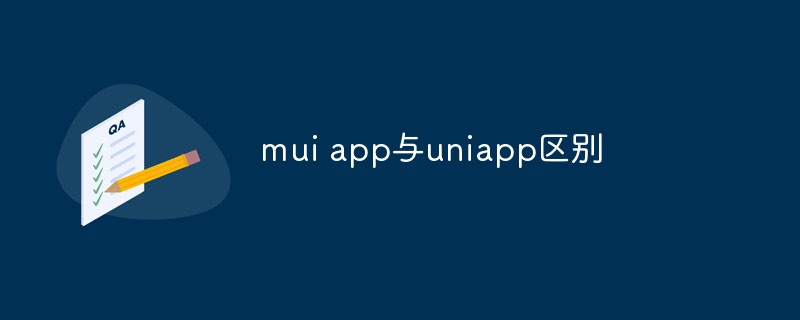Home >Web Front-end >uni-app >The difference between mui app and uniapp
The difference between mui app and uniapp
- 藏色散人Original
- 2021-01-26 10:53:5610053browse
The difference between mui app and uniapp: 1. uniapp is an open source framework that can be applied to multiple terminals. It is a framework that uses Vue.js to develop all front-end applications, while mui is a high-performance front-end that is closest to the native APP experience. Framework; 2. mui is lightweight and does not rely on any third-party JS library, etc.

The operating environment of this article: windows7 system, uni-app2.5.1 version, Dell G3 computer.
Recommended (free): uni-app tutorial
1. Advantages
1. uni-app
It will be more convenient to refer to the uni-app official website when developing (https://uniapp.dcloud.io/)
uni-app is a set of An open source framework suitable for multiple terminals, it is a framework that uses Vue.js to develop all front-end applications. Developers write a set of codes that can be published to iOS, Android, Web (responsive), and various small programs (WeChat/Alipay/Baidu /Toutiao/QQ/DingTalk/Taobao), Kuai App and other platforms.
uni-app is more friendly to front-end developers and has lower learning costs because uni-app is based on vue.js. And its encapsulated components are the same as those of WeChat applet, so the learning cost for current mainstream front-end personnel is almost 0.
uni-app uses HbuildX for development. Development using HBuilderX can be said to be extremely fast. The development speed is relatively fast, ps: I am a webstom party (very familiar with Vue), but for developing pure static pages, I use HBuilderX. I personally think it is very good, both in terms of environment and prompt effects.
2. Mui
It will be more convenient to refer to the mui official website when developing (https://dev.dcloud.net.cn/mui/ )
MUI is lightweight and does not rely on any third-party JS library. The compressed JS and CSS files are only 100 K and 60 K
Native UI: In view of many previous front-end frameworks ( Especially the responsive layout framework), the UI controls look too much like web pages and have no native feel
MUI is based on the iOS platform UI, supplementing some UI controls unique to the Android platform
There are supporting packages The development tool HBuilder provides complete code prompts and simplification of the packaging process. It also provides corresponding DEMO, which should be very user-friendly and simple for getting started.
MUI only focuses on the adaptation and rendering of UI and the encapsulation of various UI modules, and does not provide other functions unrelated to UI. This can greatly improve flexibility and facilitate integration with other frameworks. It also effectively ensures that the framework will not be too bloated, thus affecting performance.
2. Disadvantages
1. uni-app
Many people think that mini programs were launched first by WeChat. In fact, , DCloud is the pioneer of this industry. Therefore, uni-app has been around for a relatively short time, and there are many aspects that are not yet perfect.
Quick application only supports vivo, oppo, Huawei
360 applet is only supported on windows platform and needs to be opened in 360 browser
2, mui
The advantages of the official documentation are too simple, and there are few documents on the JS part. It is inconvenient to customize or modify it if necessary. There is a lack of explanatory documentation on the implementation principles and codes of the framework, making it inconvenient for experienced users to make targeted customizations or troubleshoot problems when encountering them.
There are still problems with the support for vue. When using vue to render data, mui components often fail to respond appropriately, such as being unable to pull down.
The support for third-party SDKs is not perfect enough. Currently the support for maps is not good.
The above is the detailed content of The difference between mui app and uniapp. For more information, please follow other related articles on the PHP Chinese website!

